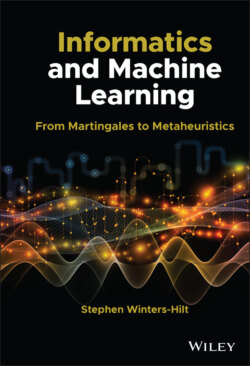Читать книгу Informatics and Machine Learning - Stephen Winters-Hilt - Страница 31
2.3 From Counts to Frequencies to Probabilities
ОглавлениеThe conventional relations on probabilities say nothing as to their interpretation. According to the Frequentist (frequency‐based) interpretation, probabilities are defined in terms of fractions of a set of observations, as the number of observations tends to infinity (where the LLN works to advantage). In practice, infinite observations are not done, and often only one observation is done (predicting the winner of a marathon, for example). In the case of one race, however, it seems intuitive that prior information would still be beneficial to predicting winners. With the formal introduction of prior probabilities we then arrive at the Bayesian interpretation. From the Bayesian perspective, prior probabilities can be encoded as “pseudocounts” in the frequentist framework (i.e. observation counts do not necessarily initialize from zero). In the computer implementations used here there are typically tuned/selected psuedocounts and minimum/maximum probability cutoffs, thus the implementations can be formally described on a Bayesian footing [1, 3].
Whenever you can list all the outcomes for some situation (like rolls on a six‐sided die), it is natural to think of the “probabilities” of those outcomes, where it is also natural for the outcome probabilities sum to one. So, with probability we assume there are “rules” (the probability assignments), and using those rules we make predictions on future outcomes. The rules are a mathematical framework, thus probability is a mathematical encapsulation of outcomes.
How did we get the “rules,” the probability assignments on outcomes? This is the realm of statistics, where we have a bunch of data and we want to distill any rules that we can, such as a complete set of outcomes (observed) and their assigned (estimated) probabilities. If the analysis to go from raw data to a probability model was somehow done in one step, then it could be said that statistics is whatever takes you from raw data to a probability model, and hopefully do so without dependency on a probability model. In practice, however, the statistical determination of a probability model suitable for a collection of data is like the identification of a physical law in mathematical form given raw data – it is math and a lot more, including an iterative creative/inventive process where models are attempted and discarded, and built from existing models.
